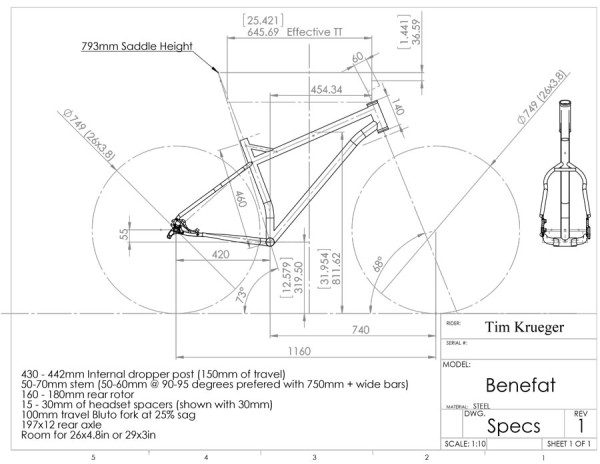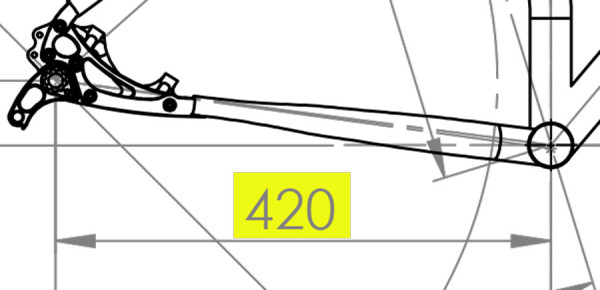
The next step in creating your custom bike, after you talk through your wants and needs with your builder, and are sure of your proper fit dimensions, is to agree with the builder what is to be done. This is typically done with a drawing, especially if you are of a more technically inclined person who wants the nitty gritty. A line drawing picture of your new bike is also kinda fun, bringing on the dreamy thoughts of where it will take you.
A drawing is also helpful for the builder, as they will typically consider it a contract. Since many custom bikes take time to make, there is a constant threat of a customer changing their mind on something, or wanting the bike to now be compatible with whatever new hub standard comes out next week. Part of working with a small custom builder is also being a good customer. Most of these guys are one-man-shows, and it takes a lot of time to talk through the process, and a lot more time to make changes. Every time you make a change, they have to put down the torch to answer the phone, boot up the computer to change the drawing, and possibly scrap materials and buy new ones. Some builders are even taking new approaches because of this amount of time, such as Steve Garro of Coconino Cycles, who only accepts orders from January 1st-15th of every year, for that entire following year.
So Collin and I have agreed to a drawing of the Benefat. More than just an assemblage of numbers, a good custom builder has a reason behind each choice they made, and those good reasons should align with what you want out of the bike. Jump past the break to see what the man behind Matter Cycles thinks in each area of geometry…

The most exciting thing to me is still this super-short chainstay length that is a feature of the Benefat. Like mentioned previously, there are no production fat bikes this short, so it will be very hard to see the show bike on display before I can get out and ride it.
Below is commentary from Collin on each of the areas of design, and why he designed the exact geometry above for exactly the riding and fit that I am looking for.
Intent of the design:
“Based on our talk / emails and all your fit data, I’ve designed this Benefat to be a bit more on the aggressive side of things while still putting you in a comfortable position. Considering you’re going to typically be running 4in tires and riding this on dirt more than snow (my build spec will be 4″ tires on 65mm rims), I really wanted to create a design that performed best under those conditions rather than trekking through snow.”
Head tube angle:
“The head tube is at 68 degrees with a 100mm Bluto fork sagged at 25%. I really like this because it doesn’t feel too slacked out but you’ll have a ton of confidence when going down gnarly stuff. The shorter rear end really allows the bike to get longer in the front and slacker without feeling wheel floppy even with big tires going uphill.”
Seat tube angle:
“At an effective 73 degrees we can get a bit more front center out of the bike and get more clearance in the back for the big tire. You have long legs and will likely be scooting back on the saddle rails a bit but I think this is a good compromise overall. You’re also going to be in more of an attack position on this bike rather than sitting and grinding out a gear. You also need to factor that you’ll be running a dropper post and will likely have it slammed when getting into the fun stuff and carving out corners.”
Chain stay length:
“I’ve found that 420mm is about as short as you can go and still have good clearance for everything including a 29x3in tire should you decide to try that out. We could technically go shorter but with bigger tires I really think 420mm is an awesome spot. This makes the bike a lot more agile. Easy to lift the front end up and over things, allows us to go slacker in the front and not have wheel flop issues when climbing. It’s also great for tight and twisty stuff, the rear end comes around nice and fast even though the front center is nice and healthy.”
Effective Top tube:
“I’ve got you right around 25.4 in. It’s a bit longer, but again we want to get that front center longer so the bike feels extra stable when the rad factor gets high. When we increase the front center and lengthen the effective top tube we need to bring the cockpit in so you’re not all stretched out. Best way to do this is with a shorter stem. You get a much better controlled feeling with a shorter stem. I’ve found that especially with bigger tires the combo of a longer front center with a shorter stem and wide bars is awesome! Fat bikes take a bit more body english and having more leverage with wide bars and a more direct steering feel with the shorter stem really works well. This setup is not just for enduro / trail bikes, it also translates really well to fat tires.”
Stand over:
“I’ve squeezed about as much stand over as I can get and still allow you to have a water bottle on the seat tube. I always like to get people on a 150mm travel dropper post too (agreed!) because you can really get things out of the way especially when you really gotta bunny hop something. By having the longer dropper post we can reach the saddle height we need easy and keep that frame out of the way even with a slightly bigger head tube.”
Bottom bracket drop:
“Normally I go with 60mm here especially if someone is going to run full fat tires most of the time. But with 4in tires and the possibility of you running 27.5x3in tires, I think 55mm will be a touch better. You’ll effectively be around 12.5in in BB height while riding. I think that’s a nice sweet spot. If you like to get as low as possible though and don’t mind the pedal strike now and then and want more of a carving feel we could go a touch lower, but I wouldn’t advise going much lower. You have to figure the bigger tires are a lot more dynamic too especially with a 100mm travel fork. you don’t want to get jammed up on your pedals when you’re smashing through rock crawly sections.”
Drop / Head tube length:
“I like to get riders a bit more upright. I think the stability you get of feeling a bit more in the bike especially when going down steep stuff is totally worth it. I find that getting the leverage you need over the front wheel to drive through corners doesn’t require a lot of drop, especially when you are really getting after it and are not likely to be on the saddle anyways because it’s dropped and out of the way. With the longer front center you’ve got more leverage on the front wheel with your body weight.”
Wheelbase:
“Long bikes rule, but only when they are long in the front and shorter in the back. At 1160mm this is going to feel really stable when going fast and doing stupid stuff, but because the rear is short it’s not gonna corner like a tank. Your weight distribution will be spot on for proper shredding.”

After reviewing the drawing to insure that it has all of my requests incorporated, and as a second set of eyes to check for errors, I approved it back to Collin to start building. Check in for the next edition as we start to melt some steel.